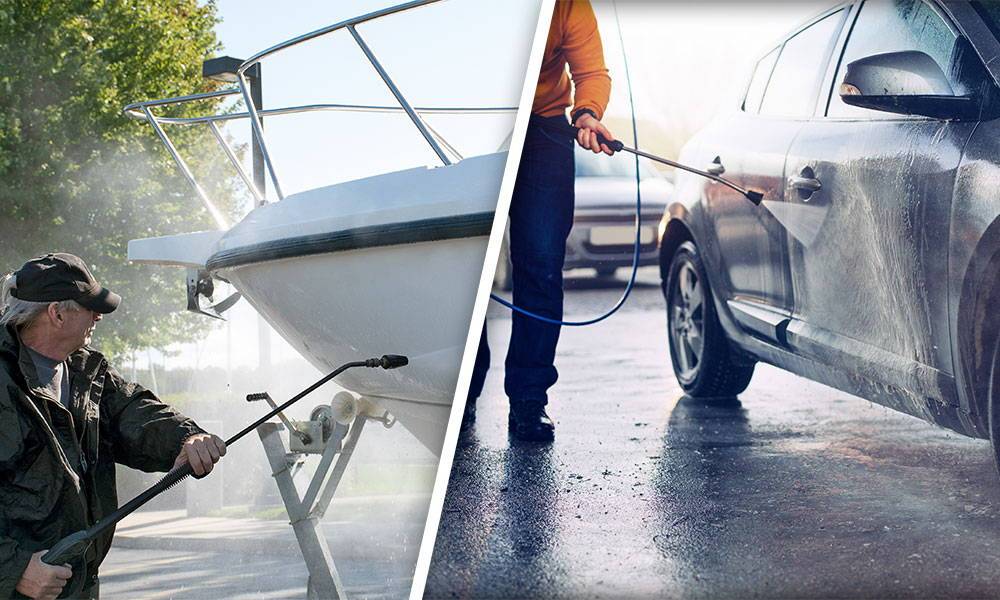So you got yourself a new boat. Perhaps a center console to take out fishing, a small bowrider with just enough space for the family, or a nicer, larger deck boat that serves as the main party venue all summer long.
Boats are a ton of fun for the whole family and all your friends. But when the time comes for washing and maintenance, suddenly everybody’s vanished, and you’re standing there, buckets in hand, wondering where to even begin.
The hull is cloudy and rough, the seats are moldy, the deck is full of leaves, and you can smell the fish guts from around the corner. Maybe your boat is not in such a disastrous condition, but give it a couple of months on the water, and it will get there and much worse.
In this article, we’ll go through all the steps of detailing a fiberglass gelcoat recreational boat.
★★★★★ "Saw this being promoted on a big YouTube channel and thought why not try it. Was a bit skeptical but WOW. Super easy to apply and car is shining. Water still pelts off 3 weeks later! Gonna ditch the wax and will continue to use." - Josh S.
Boat vs. Automotive Detailing
Boat detailing can seem overwhelming at first, especially if you own a 20-30 ft vessel. It is a lot of work, but if you’re used to detailing your own car or truck, you’ll be surprised by how much you already know.
Of course, the environment, contamination sources, and materials are different, so there are some new techniques you need to master. However, the methodology is practically the same:
- Deep cleaning inside and out
- Restoring interior items like glass, metal trim, vinyl upholstery, carpeting, and other fabrics
- Decontamination and claying the hull
- Polishing the Gelcoat
- Applying waxes, sealants, or ceramic coatings
And while marine-specific products tend to offer better performance over time, the majority of products and tools that you use on your car will also work for your boat.
Because boat and automotive detailing are similar, we’ll assume you already know how to do this to your own car. However, remember to keep in mind the differences between the two when working on water vessels.
Gear You’ll Need Before You Start
Before you begin, go over the checklist below to make sure you’ve got everything you need.
Essential Products
- Boat soap - You can buy marine-grade soap from any boat supply store. Alternatively, you can use car soap that’s sitting at home or even regular dish soap. Our Decon Wash Pack includes our powerful Decon Soap, which will remove the vast majority of contamination, strip waxes, and sealants and give you a clean base for follow-up procedures.
- Wax or sealant - Marine waxes are formulated specifically for saltwater environments. Traditional automotive waxes do not provide nearly enough longevity when applied to boats. Modern synthetic waxes and hybrid wax-sealants—like our product Mirror Shine—can give you up to 6 months of protection on a land vehicle. On a water vessel, you should probably not expect more than half that duration time, but that is true for most automotive detailing products.
- Ceramic coating - The ultimate protection for your hull is, of course, a ceramic coating. They offer better protection against salt, hard water, UV radiation, oxidation, algae, fish guts, hard parties, and anything else you can encounter on the water. Torque Detail’s 7H 3-step Ceramic Coating offers up to 2 years of protection, water beading, and deep glossy finish when applied to land vehicles.
- Vinyl cleaner - Modern boat interiors are predominantly upholstered in vinyl or other plastic material, so they could endure a wet environment and be easier to maintain. Torque Detail’s Intra Clean and Intra Shield products are amazing for cleaning, restoring, and protecting plastic, vinyl, composite materials, leather, and fabrics of all kinds.
- Glass cleaner - Any product you use around your car or house will do.
Essential Tools
- Wash mitt, sponge, reusable synthetic clay - All the basic tools you use for washing and detailing cars, you also need for your boat.
- Microfiber towels - You need lots of them. Consider our Torque Detail’s 12-pack high-quality microfiber towel bundle. They are great for cleaning, drying, applying, or removing various products and coatings.
- Shop vacuum - A good vacuum is essential for cleaning heavily soiled boats, removing dried leaves, dirt, fish, and food leftovers, as well as clean wet storage compartments and bilge areas.
- Pressure washer or garden hose - Boats are more difficult to clean than cars. Pressure washers are the primary choice. Garden hoses with high-pressure attachments could do the trick, but you’ll have to work harder and longer to get the same results.
- Soft bristle brushes with an extension handle - You’ll have lots of scrubbing to do inside the boat and out.
The “Nice-to-Have” tools
- Foam cannon, foam gun, or pump sprayer - Boats have lots of surface area to cover, so you’ll appreciate a tool that quickly and effectively soaps up your work area.
- Degreaser / Bleach - For severely soiled and abandoned boats, you’ll need a more powerful degreaser and some bleach.
- Metal polish - Overtime, metal finishes will dull by virtue of hard water and salt deposits, corrosion, and a plethora of contamination, including your own greasy fingers.
- Rotary polisher and dual action polisher - Gelcoats are a lot harder than automotive clear coats and pick up a nasty layer of oxidation over time. Polishing requires a lot more effort, grit, and heat, so you’ll have to resort to more powerful machinery.
- Gelcoat cutting and polishing compound, wool, and foam pads.
Eco-Friendly Boat Detailing Tips
★★★★★ "Saw this being promoted on a big YouTube channel and thought why not try it. Was a bit skeptical but WOW. Super easy to apply and car is shining. Water still pelts off 3 weeks later! Gonna ditch the wax and will continue to use." - Josh S.
You love boating because it gets you closer to nature and lets you admire the beautiful aquatic life in all of its glory. We all want to keep this environment clean and healthy. So before availing of boat detailing services, ensure that they are taking care of the environment. Equally important is to share with boat detailers our concern about the related hazards.
In light of this, you need to acknowledge that many cleaning and detailing products, and especially degreasers and bleaches, are toxic to fish, water animals, corals, and aquatic plants. Dumping large amounts of harsh detergents in the water harms the entire ecosystem and will cause long-term negative effects on all marine life.
Please consider washing your boat with biodegradable soap products and avoid using degreasers and bleaches, unless absolutely necessary.
Don’t wash your boat while afloat. Use one of the designated wash areas in well-equipped marinas, or wash it on its trailer near a sewage drain, so the water and all cleaning products will be collected and treated before going into the open ocean.
How To Super Clean Your Boat Like a Pro
If you wash your boat regularly after every use, like you’re supposed to, you shouldn’t ever need harsh chemicals. You can approach a professional boat detailer who will ensure that every minute detail is given due importance. Boat cleaning can be a tricky job if you ignore simple things. First, make sure to remove the barnacles that are stuck at the bottom and sides of the boat. You can simply scrub it down with a sponge and a bucket of your preferred soap - just like you do with your car. Remember there can be water spots on your boat as well. After washing your boat, you can use the chamois and do the buffing from the topside to the bottom of your boat in three steps:
- Make sure to do the compounding after the oxidation is off your boat.
- Rub the polish.
- Apply wax.
Remember, applying a hazard-free plastic spray cleaner is an important element of maintaining the isinglass.
In reality, despite our best intentions, there are many times we just can’t get to our chores in time...or at all...for months.
Exterior Cleaning
Boats are engineered to endure harsh salty environments, stay wet for prolonged periods, and sit outside, often without any shielding from the sun or weather conditions. The materials are more rugged and therefore will take significant abuse before they exhibit any wear.
All of this means you can use stronger cleaning products and tools to get the job done quicker and easier. In fact, most professional detailers will go straight for a degreaser and water mix, often adding a squirt or two of bleach.
Here’s a good cleaning procedure you can follow:
- Rinse the boat with a pressure washer and clean water to knock off all the loose dirt and algae.
- Spray the hull with a foam cannon or a pump sprayer. We recommend starting with soap and moving onto a degreaser, only if you need to. For small boats, you can just use a bucket and sponge.
- Scrub the hull with a sponge, wash mitt or, soft bristle brush. Don’t worry about using the brush, the gelcoat is hard and durable, and it can take some scrubbing, just make sure to buy the softest one available.
- Rinse again with a pressure washer.
You will probably have to repeat the procedure to remove all the dirt and switch to more aggressive cleaning solutions for the worst areas.
Avoid working in direct sunlight if you can. You don’t want any cleaning products drying on the surface. If you can’t help it, work in smaller sections and frequently rinse off to keep the surface wet at all times.
Interior Cleaning
Depending on the condition of the interior, you can pressure wash the interior as well. Simply foam it up and pressure-wash it several times to remove the majority of the mold, mildew, and grime that has collected in all the folds and crevices.
Modern fiberglass boats are engineered in such a way that utilizes all the available volume. Boats are laden with various storage compartments, cubbyholes, foldable seats, tables, etc. There’s an unbelievable amount of surface area, which you have to clean, so make sure you get at all the crevices and folds, where dirt and mold will settle.
- Intra Clean + Intra Shield: Two-Step Interior Detailing Kit.
- Leather Restore: Your Go-To Leather Restoring/Cleaning Product.
Restoring Vinyl Upholstery
You may skip the pressure-washing if the boat is in clean enough condition. But, you will still have to individually wash every seat and cushion with vinyl cleaner, magic erasers, and microfiber towels.
Boat upholstery is typically white to prevent overheating under the sun. The seats might not look very dirty, but once you start scrubbing, you’ll visibly see the color change back to its original hue.
There’s no magic here, you just have to be meticulous and make several passes, until you get all the stains and dirt out. Use a detailing brush to hit all crevices, seams, and stitching to get the muck out of there. If you encounter tough stains, mold, or grime, you can use a degreaser diluted 5:1 with water. Stay away from bleach as it can damage the stitching and deteriorate the upholstery over time if not thoroughly washed off.
Finally, apply a vinyl protectant to all upholstered items to prevent the vinyl from drying out and cracking from UV exposure and keep it easier to clean next time around.
Washing Carpets / Vacuuming Carpets
If you have carpets in your boat, you can wash them with pretty much any cleaner you have available - all-purpose, car soap, boat soap - anything works. Mix yourself a bucket, grab a stiff hand brush and scrub the heck out of it. Finally, rinse thoroughly with water.
Polishing Metal Trim
Metal rails, poles, handles, ladders, and other hardware can be polished similarly to chrome bumpers and aluminum wheels on cars. Grab any metal polish and a microfiber towel and just rub the surfaces until they brighten up. After a few passes, the metal hardware will regain its shiny reflective finish.
Taking Care of the Engines
Don’t forget about cleaning the engine.
- If you have an outboard motor, just treat it like another part of the hull. Clean, degrease and seal the entire assembly, except the propeller.
- If you have an inboard motor, clean it the same way you would the engine bay of your car. Visit our dedicated guide - How To Clean Your Car Engine Bay
Polishing Fiberglass Gelcoat Hulls
One of the key things to know about boat detailing is how to work with gelcoats.
The gelcoat comprises the outermost layer on fiberglass boats. It’s a type of synthetic resin, analogous to the clear coat on cars and trucks, however, considerably harder, thicker, and much more durable.
Gelcoat is more difficult to scratch, but not impenetrable. It's porous, and after sitting under the sun for extended periods, oxidizes forming a chalky white layer on the surface. It’s rough to the touch and quite unpleasant to look at.
To remove this oxidation, you need to polish the gelcoat. Because it’s much harder than a clear coat, you’ll have to use more aggressive pads, compounds, and machines.
A standard dual action polisher, which is a staple in paint correction and scratch removal, will not generate enough friction to effectively polish gelcoat. It can do it with an aggressive pad and compound, but will probably take too much time and effort.
The typical way to polish a gelcoat hull is a two-step method:
Step 1: Polish with a rotary machine, a wool pad, and a medium-heavy grit compound. Use the edge to concentrate the friction and move the pad in straight motions, overlapping each stroke by 50% and alternating side to side, with up and down passes. It will remove the oxidized layer and the majority of scratches but will scuff the surface and leave a dull finish.
Step 2: Polish with a rotary or dual action machine, a foam pad, and a polishing compound. This pass will remove the micro-scratches from the previous operation and restore the lustrous, glossy finish of the gelcoat.
Gelcoat is a lot more forgiving to polishing mistakes than a clear coat is. That said, you don’t want to go overboard and polish more than you have to. Every polishing operation will thin out the gelcoat and overtime this can compromise the integrity of the fiberglass underneath. It doesn’t tend to happen if you’re polishing properly and keeping the hull protected, but keep it in mind.
If the gelcoat has just a few superficial imperfections, you should try claying the surface and skipping the polishing altogether.
Waxing / Sealing / Coating The Hull
Regardless of whether you’ve polished the gelcoat or just deep cleaned the boat, you’ve inevitably removed any wax or sealant that was protecting the hull. Leaving it like that will ruin all your hard work the next time you install it back into the water. If you want your boat to keep looking nice and shiny, you need to add a topcoat.
Boat owners usually resort to applying a layer of marine wax. That’s nothing like the carnauba wax you’re used to putting on your classic Detroit muscle. Modern companies keep calling it wax because that’s what you’re used to, but in reality, these products are most often synthetic sealants. They fill in the pores of the gelcoat and crosslink with the surface to create a tight, lasting bond that will endure for 6 to 12 months. The protective layer prevents dirt and contamination from settling on the surface and makes the boat easier to wash - often with just a pressure washer.
You apply wax and sealant the same way you do on your car. However, because the hull has a lot of surface area and relatively flat geometry, you can use a machine to quickly and evenly apply the product.
Ceramic Coating Your Boat (What You Need To Know!)
Ceramic coatings are massively popular right now. And for good reason! They can even be done quite easily and affordably with the right product!. This is the ultimate protection for automotive clear coats and also marine gelcoats. It protects the underlying surface from UV rays, salt and hard water deposits, chemical etching, algae, and dirt. It makes the surfaces ultra-slick and hydrophobic, makes the boat easier to clean, and it creates a deep glossy finish that lasts for years if properly maintained.
Again, you apply a ceramic coating in the same manner as you do on a car. Read all about ceramic coatings in our blog:
★★★★★ "Saw this being promoted on a big YouTube channel and thought why not try it. Was a bit skeptical but WOW. Super easy to apply and car is shining. Water still pelts off 3 weeks later! Gonna ditch the wax and will continue to use." - Josh S.
Boat Detailing Summarized:
That was boat detailing in a nutshell - quite similar to automotive care, but with many nuances which you’ll learn once you start work on your boat.
If it seems intimidating at first, just remember that it's nothing more than a collection of simple, but tiring tasks - cleaning, more cleaning, final cleaning, then lots of polishing, waxing, coating, and protecting.







